A Five-Hole Pressure Probe Based on Integrated MEMS Fiber-Optic Fabry-Perot Sensors
Abstract
:1. Introduction
2. Design and Principle
2.1. Probe Design and Sensor Principle
2.2. Interrogation Method for FP Cavity Length
3. Simulation and Production
3.1. Probe Fluid Simulation
3.2. Mechanical Stimulation of Sensitive Unit
3.3. Sensitive Unit Integrated MEMS Process Preparation
3.4. The Five-Hole Pressure Probe Preparation
4. Experiments and Discussion
4.1. Sealing Test and Analysis
4.2. Static Pressure Test and Analysis
5. Conclusions
Author Contributions
Funding
Data Availability Statement
Conflicts of Interest
References
- You, Y.; Teng, J.; Zheng, X.; Zhou, X. Review of Aero-engine Temperature Distortion Research. Nanjing Hangkong Hangtian Daxue Xuebao/J. Nanjing Univ. Aeronaut. Astronaut. 2017, 49, 283–300. [Google Scholar]
- Liang, Z.; Liu, Y.; Yang, Y.; Yang, Y.; Yang, H. Aero-Engine Air Intake and Its Location Design. J. Res. Multidiscip. Methods Appl. 2022, 1, 01220101001. [Google Scholar]
- Xu, Z.; Gao, R.; Da, X. Assessment and measurement of total pressure distortion based on five-hole-probe for S-shaped inlet. J. Exp. Fluid Mech. 2018, 32, 78–86. [Google Scholar]
- Jian, J.; Jiyun, Q.; Haigang, Z. Study on Development and Calibration Method for Five-hole Probe. Eng. Test 2014, 54, 59–63. [Google Scholar]
- Naughton, J.; Cattafesta, L., III; Settles, G. Miniature, fast-response five-hole conical probe for supersonic flowfield measurements. AIAA J. 1993, 31, 453–458. [Google Scholar] [CrossRef]
- Gaetani, P.; Persico, G. Technology Development of Fast-Response Aerodynamic Pressure Probes. Int. J. Turbomach. Propuls. Power 2020, 5, 6. [Google Scholar] [CrossRef]
- Bryer, D.W.; Pankhurst, R.C. Pressure-Probe Methods for Determining Wind Speed and Flow Direction; HMSO: London, UK, 1971.
- Ned, A.; Goodman, S.; Vandeweert, J.; Carter, S. High Accuracy, High Temperature Pressure Probes for Aerodynamic Testing. In Proceedings of the 49th AIAA Aerospace Sciences Meeting including the New Horizons Forum and Aerospace Exposition, Orlando, FL, USA, 4–7 January 2011. [Google Scholar]
- Liang, H.; Jia, P.; Liu, J.; Fang, G.; Li, Z.; Hong, Y.; Liang, T.; Xiong, J. Diaphragm-free fiber-optic Fabry-Perot interferometric gas pressure sensor for high temperature application. Sensors 2018, 18, 1011. [Google Scholar] [CrossRef] [PubMed]
- Yan, Z.; Zhu, S.; Zhang, Y.; Jia, P.; Liu, J.; Liu, L.; Zhu, F.; Niu, H.; An, G. High temperature and high pressure fiber microsphere Fabry–Perot sensor based on Vernier effect and FBG. IEEE Sens. J. 2023, 23, 9301–9307. [Google Scholar] [CrossRef]
- Ran, Z.; Liu, S.; Liu, Q.; Wang, Y.; Bao, H.; Rao, Y. Novel High-Temperature Fiber-Optic Pressure Sensor Based on Etched PCF F-P Interferometer Micromachined by a 157-nm Laser. IEEE Sens. J. 2015, 15, 3955–3958. [Google Scholar]
- Heckmeier, F.M.; Iglesias, D.; Kreft, S.; Kienitz, S.; Breitsamter, C. Development of unsteady multi-hole pressure probes based on fiber-optic pressure sensors. Eng. Res. Express 2019, 1, 025023. [Google Scholar] [CrossRef]
- Wang, Y.; Ni, X.; Wang, M.; Cui, Y.; Shi, Q. Demodulation of an optical fiber MEMS pressure sensor based on single bandpass microwave photonic filter. Opt. Express 2017, 25, 644–653. [Google Scholar] [CrossRef] [PubMed]
- Liu, Y.; Jing, Z.; Liu, Q.; Li, A.; Teng, C.-A.; Cheung, Y.; Lee, A.; Tian, F.; Peng, W. Differential-pressure fiber-optic airflow sensor for wind tunnel testing. Opt. Express 2020, 28, 25101–25113. [Google Scholar] [CrossRef] [PubMed]
- Zhu, C.; Chen, Y.; Gerald, R.E.; Huang, J. Probing Changes in Pressure with Sub-pascal Resolution Using an Optical Fiber Fabry-Perot Interferometer. IEEE Trans. Instrum. Meas. 2020, 69, 6556–6563. [Google Scholar] [CrossRef]
- Liu, J.; Jia, P.; Feng, F.; An, G.; Xiong, J. MgO Single Crystals MEMS-Based Fiber-Optic Fabry–Perot Pressure Sensor for Harsh Monitoring. IEEE Sens. J. 2020, 21, 4272–4279. [Google Scholar] [CrossRef]
- Zhou, H.; Sheplak, M. A MEMS-based fast-response miniature five-hole probe with optical pressure transducers. J. Microelectromech. Syst. 2020, 29, 960–965. [Google Scholar] [CrossRef]
- LI, J.; Zhu, Y.; Wang, N.; Li, J. An Algorithm for Improving the Signal Stability of the Fast Fiber Optic Fabry-Perot Nonscanning Correlation Demodulation System. Acta Photonica Sin. 2015, 44, 0106005. [Google Scholar]
- Li, J.; Jia, P.; Wang, J.; Liu, J.; An, G.; Xiong, J. Silica-MEMS-based Fiber-optic Fabry-Perot Pressure Sensor for High-temperature Applications. Acta Photonica Sin. 2022, 51, 0606005. [Google Scholar]
- Di Giovanni, M. Flat and Corrugated Diaphragm Design Handbook; Routledge: New York, NY, USA, 2017; pp. 21–29. [Google Scholar]
- Zhang, T.; Jiang, Y.; Ma, W. A high fineness optical fiber FP pressure sensor based on MEMS. Laser Optoelectron. Prog. 2019, 56, 170625. [Google Scholar] [CrossRef]
- Liu, B. Research on Key Technologies of Microfiber Acoustic Sensor Based on Fabry-Perot Interferometer. Doctoral Dissertation, Harbin Institute of Technology, Harbin, China, 2017. [Google Scholar]
- Wang, L. Research on High Temperature Sensing System of Optical Fiber Fabry-Perot. Master’s Thesis, Chongqing University, Chongqing, China, 2022. [Google Scholar]
- Zhenrui, Z.; Zongjia, Q.; Kang, L.; Guoqiang, Z. Review on demodulation methods for optic fiber Fabry-Perot sensors. Opto-Electron. Eng. 2022, 49, 210411–210419. [Google Scholar]
- Liu, Y.; Jia, P.; Yuan, S.; Wang, J.; Wan, S.; Zhao, J.; Liu, D.; Xue, Y.; Xiong, J. Design of a fiber-optic composite probe for engine intake total temperature and pressure. Infrared Laser Eng. 2022, 51, 20220685-1. [Google Scholar]
- Zhang, Z.; Zhai, L.; Guo, J.; Zhu, Z.; Chen, G. Numerical Analyses of Static Characteristics of Liquid Annular Seals Based on 2D LBM-LES Model. Shock Vib. 2021, 2021, 6631557 . [Google Scholar] [CrossRef]
- Jiang, C.; Song, C.; Lei, X.; Liu, X.; Zhang, P. Study on the multi-direction pressure measurement technology of aero engine internal flow based on an integrated probe. Chin. J. Sci. Instrum. 2021, 42, 9–19. [Google Scholar]
- Wang, S.; Wang, J.; Li, W.; Liu, Y.; Li, J.; Jia, P. A mems-based high-fineness fiber-optic fabry–perot pressure sensor for high-temperature application. Micromachines 2022, 13, 763. [Google Scholar] [CrossRef] [PubMed]
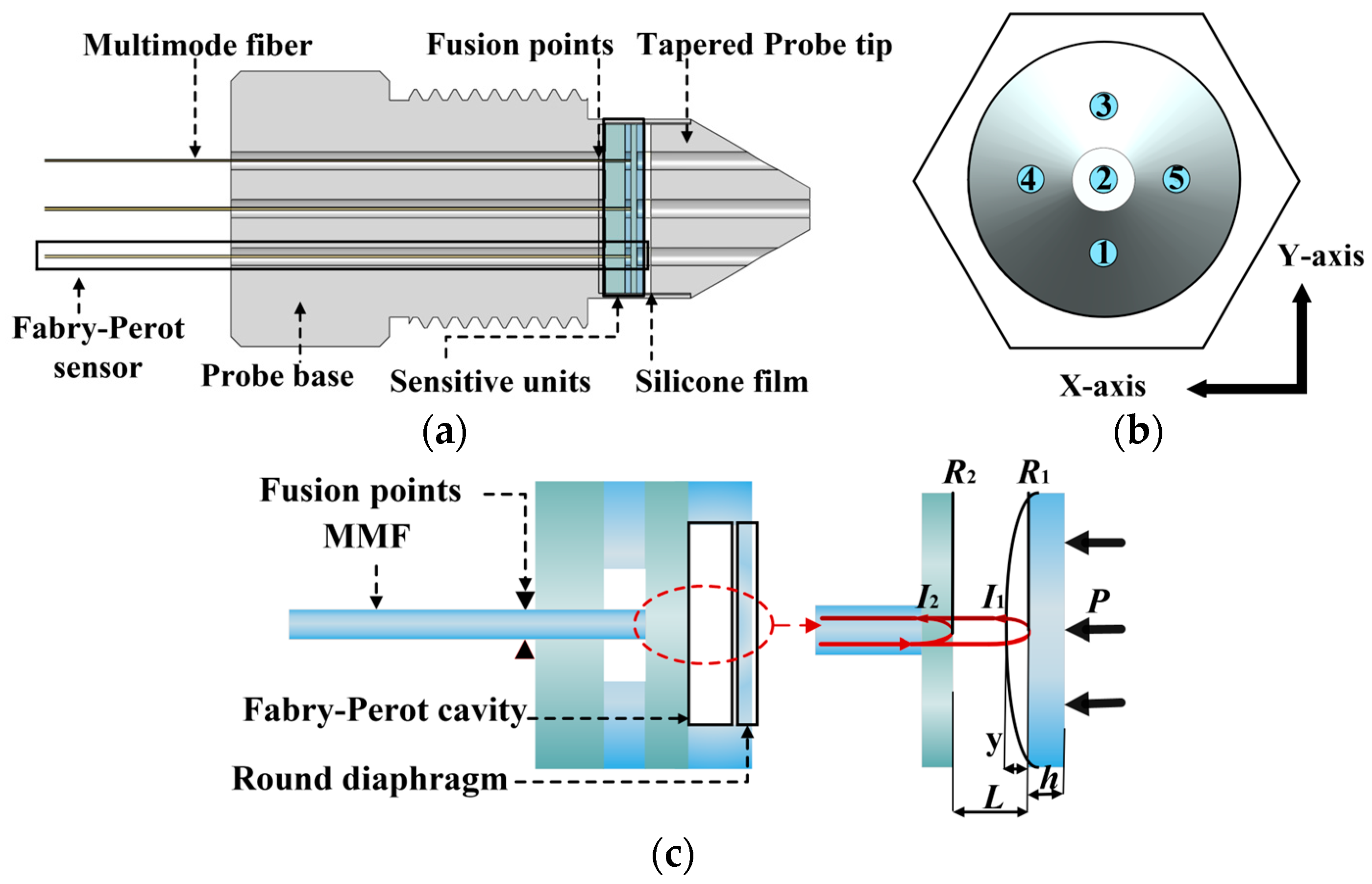


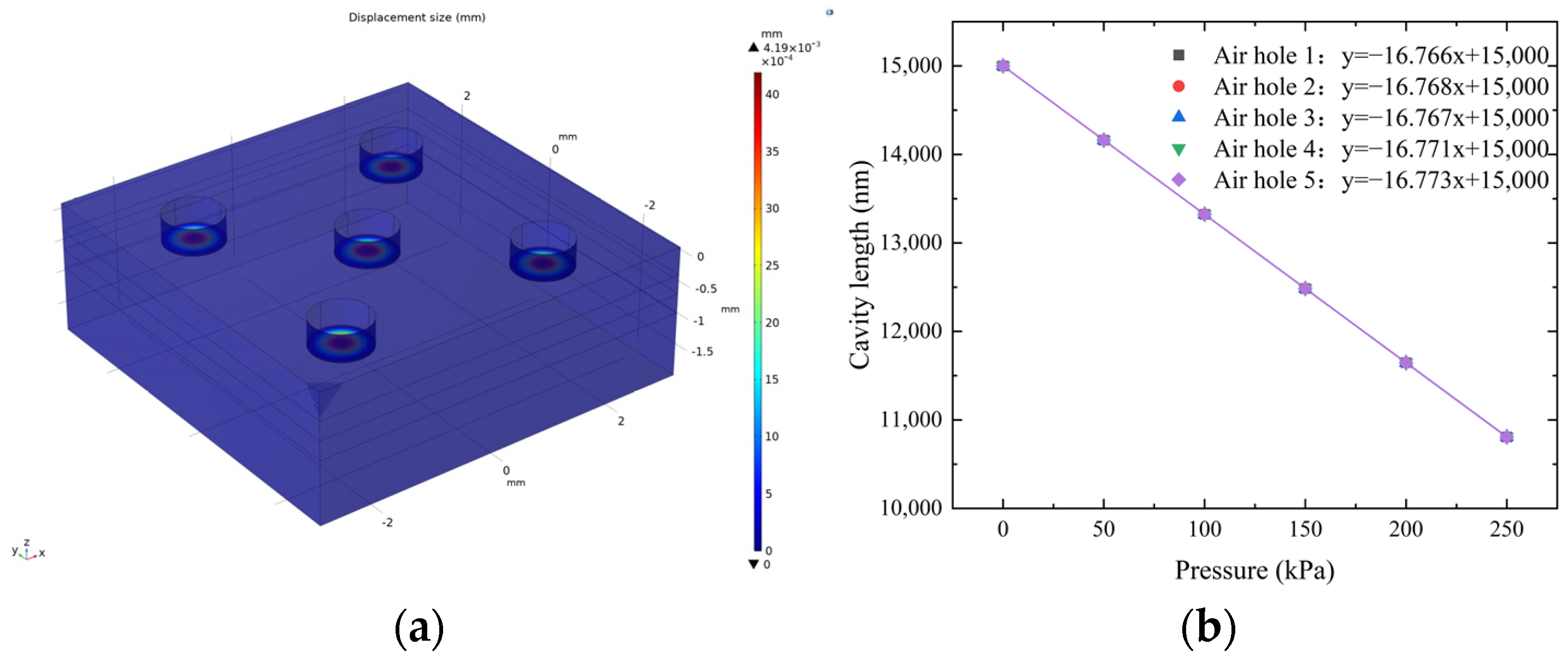

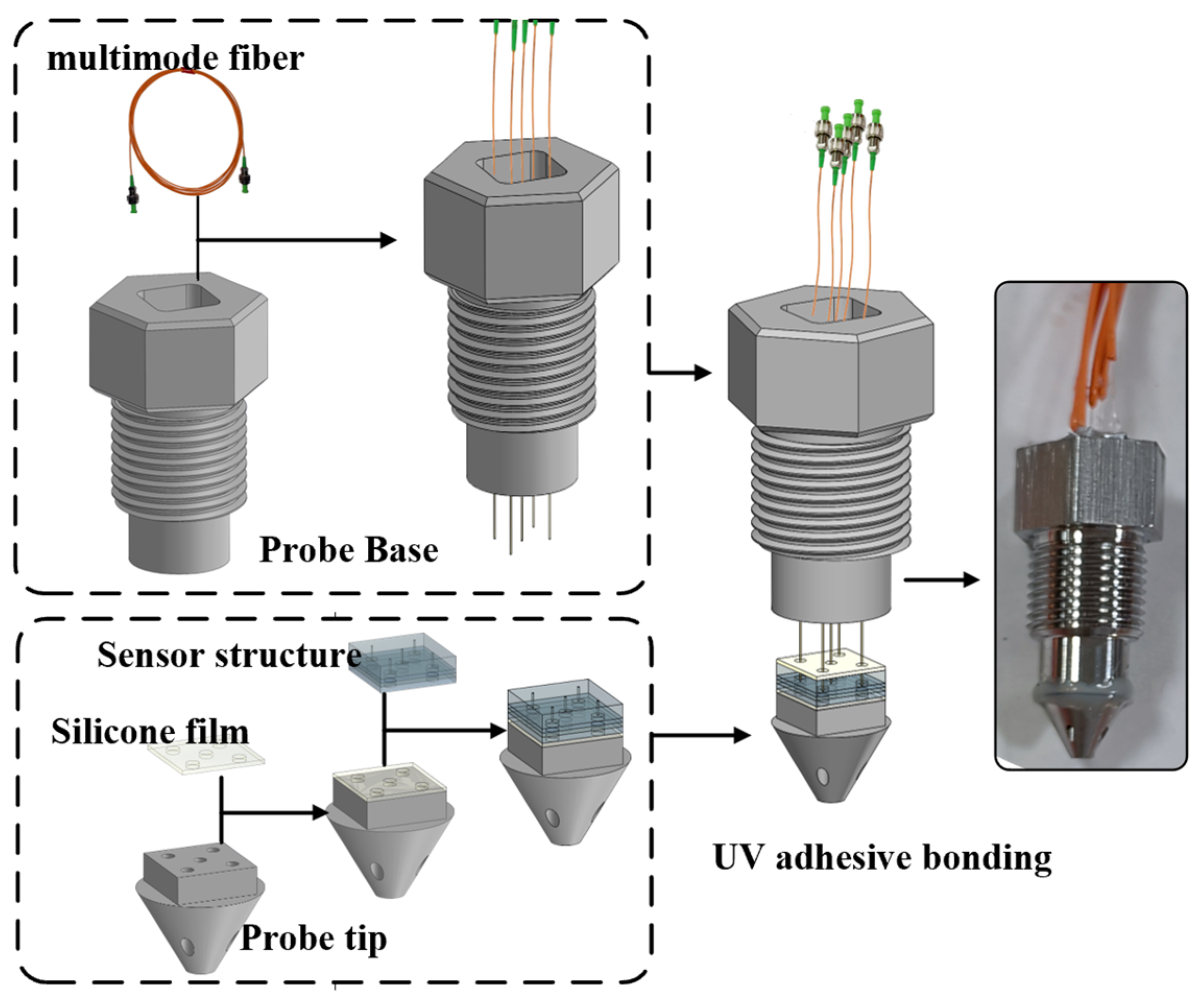



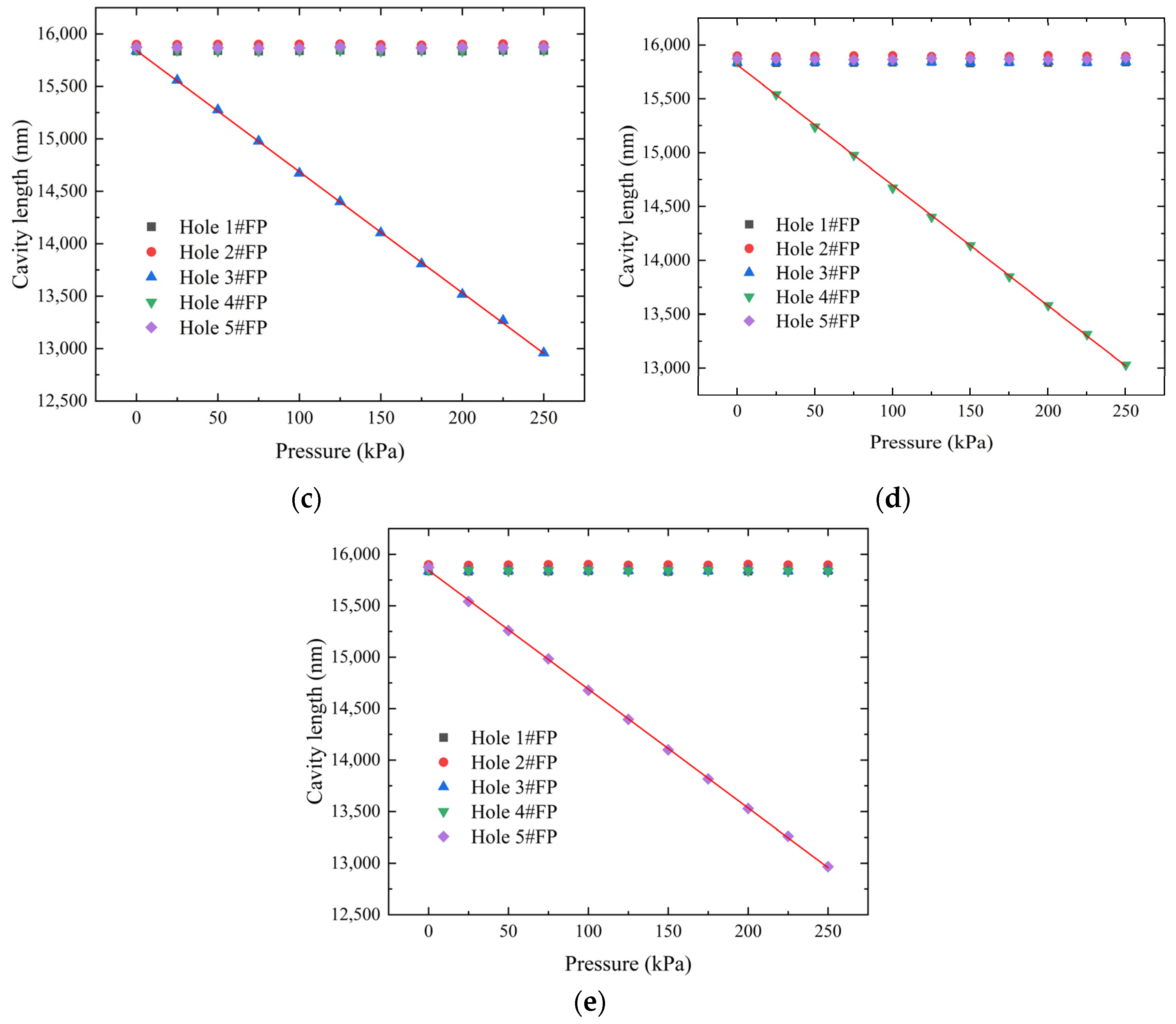
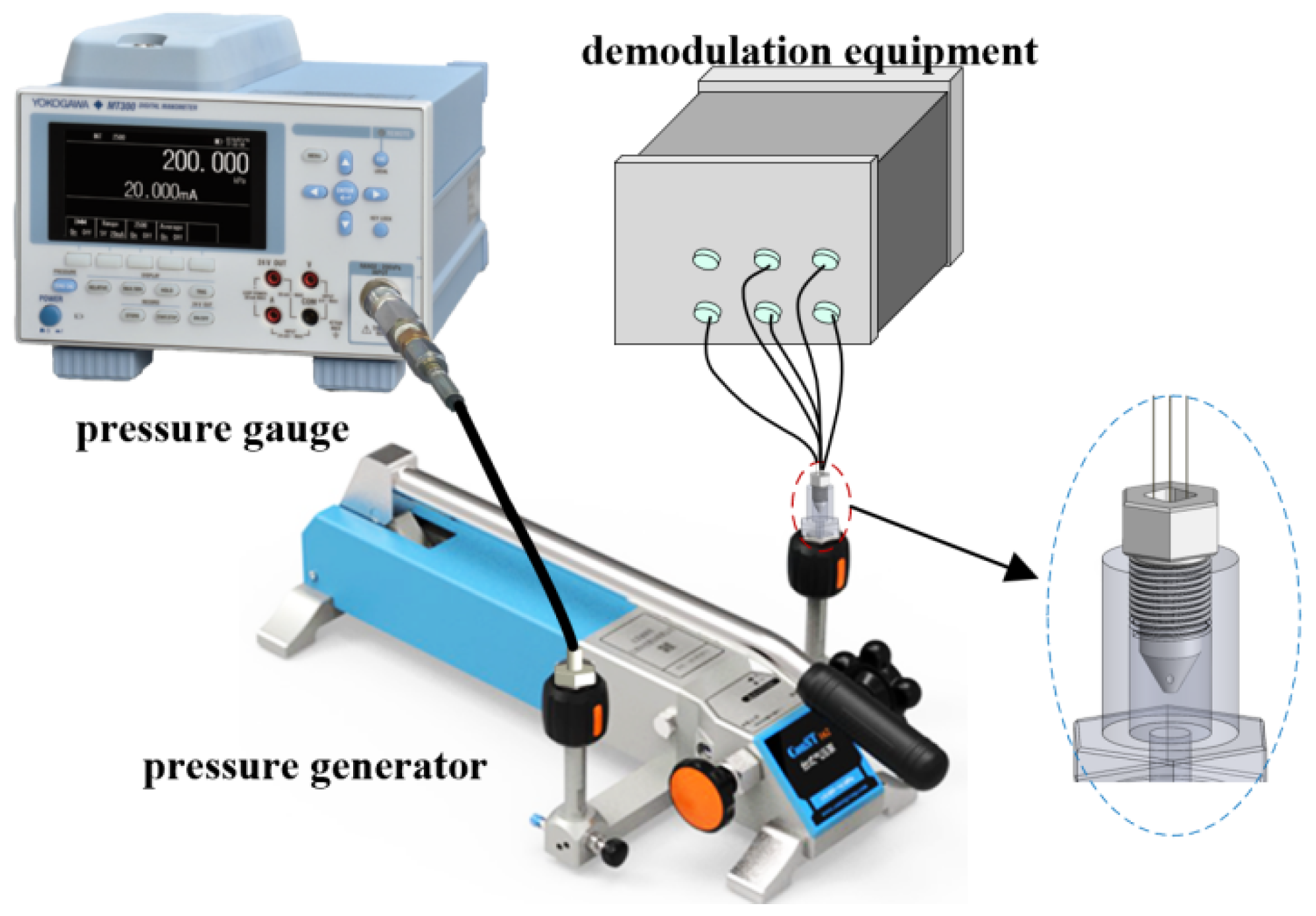

| Performance | Hole 1#FP | Hole 2#FP | Hole 3#FP | Hole 4#FP | Hole 5#FP |
|---|---|---|---|---|---|
| Initial cavity length/nm | 15,837 | 15,898 | 15,840 | 15,840 | 15,871 |
| Average sensitivity/nm·kPa−1 | 11.061 | 11.256 | 11.546 | 11.166 | 11.528 |
| Nonlinear error/% | 0.789 | 0.701 | 0.792 | 1.083 | 1.058 |
| Minimum R2 | 0.99979 | 0.99989 | 0.99986 | 0.99964 | 0.99979 |
Disclaimer/Publisher’s Note: The statements, opinions and data contained in all publications are solely those of the individual author(s) and contributor(s) and not of MDPI and/or the editor(s). MDPI and/or the editor(s) disclaim responsibility for any injury to people or property resulting from any ideas, methods, instructions or products referred to in the content. |
© 2024 by the authors. Licensee MDPI, Basel, Switzerland. This article is an open access article distributed under the terms and conditions of the Creative Commons Attribution (CC BY) license (https://creativecommons.org/licenses/by/4.0/).
Share and Cite
Song, Y.; Ma, S.; Zhao, J.; Liu, J.; Wang, J.; Cui, Y. A Five-Hole Pressure Probe Based on Integrated MEMS Fiber-Optic Fabry-Perot Sensors. Micromachines 2024, 15, 554. https://doi.org/10.3390/mi15040554
Song Y, Ma S, Zhao J, Liu J, Wang J, Cui Y. A Five-Hole Pressure Probe Based on Integrated MEMS Fiber-Optic Fabry-Perot Sensors. Micromachines. 2024; 15(4):554. https://doi.org/10.3390/mi15040554
Chicago/Turabian StyleSong, Yumiao, Shuanghui Ma, Jichun Zhao, Jia Liu, Jingyi Wang, and Yongjun Cui. 2024. "A Five-Hole Pressure Probe Based on Integrated MEMS Fiber-Optic Fabry-Perot Sensors" Micromachines 15, no. 4: 554. https://doi.org/10.3390/mi15040554




